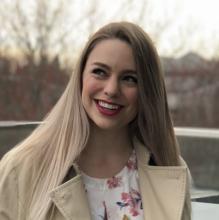 By Marie-Soleil Smith, PhD Candidate, Côté Lab
By Marie-Soleil Smith, PhD Candidate, Côté Lab
As researchers, we often fixate on conducting and publishing research. By doing so, we may glance over how to best communicate those years of research to the general public. Bridging the gap between the sterile lab environment and people from all walks of life is key to showing them that what we do matters and justifies continued support, especially now with the COVID-19 pandemic.
My extended time working from home has afforded me the time and privilege of interviewing four fellow researchers from my lab, the Côté lab, who are trail-blazers in the science communication landscape and have set up a whole new template for summer student projects. The project was supported by the CBR-SBME Summer Studentship Program, which provides undergraduate students with an opportunity to get hands-on research experience during the summer months and to present their research at the annual CBR Research Day. In the Côté lab, Mahtab S. Gill (CBR-SBME Undergraduate Summer Student), Loïc Caloren (Graduate Student), Nicolas Gauthier (Undergraduate Co-op Student), and Nancy Yang (Graduate Student) have used their collective scientific knowledge and laboratory experiences to communicate everything a lay person should know about two important viruses, HIV and SARS-CoV-2. To successfully condense the molecular biology, immunology, screening, testing, treatment, and prevention of HIV and SARS-CoV-2 into five 15-minute videos fit for high school students is a feat worthy of learning more about.
After transcribing our two 40-minute zoom calls to 11 pages of content, and then editing down to a mere 2.5 pages, I present to you the “Going Viral” video series interview!
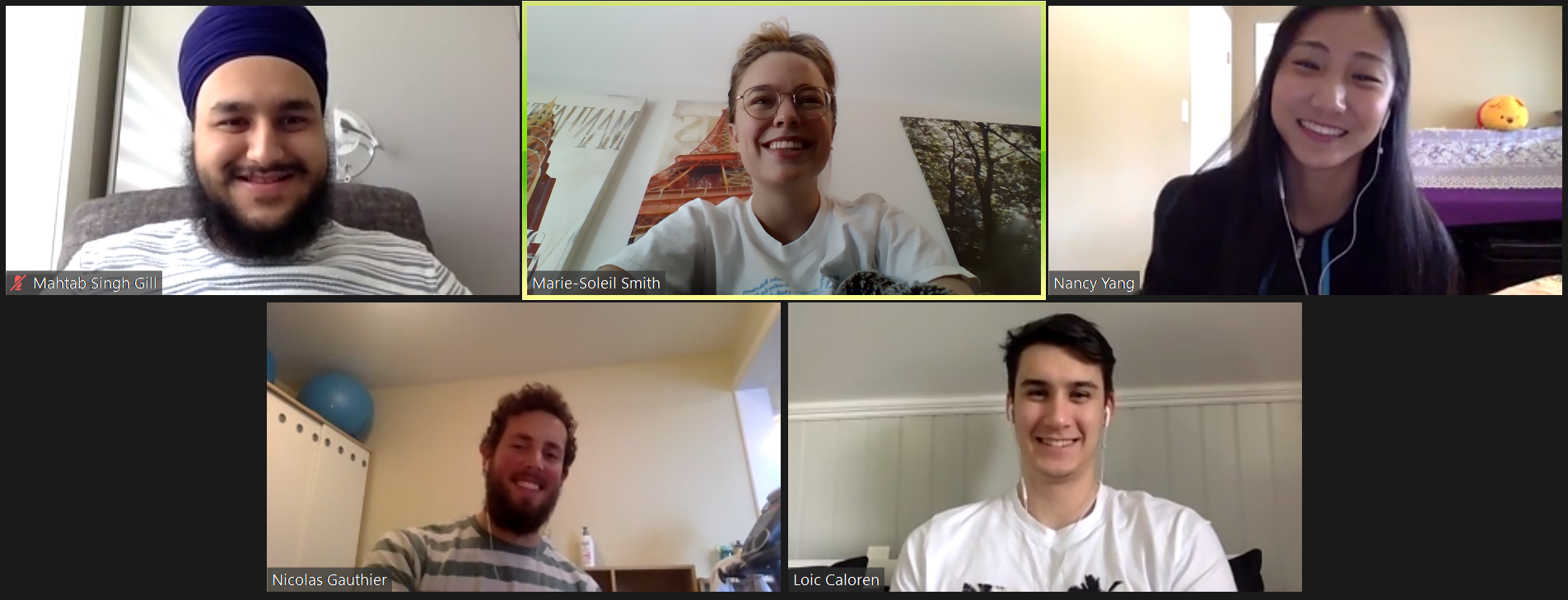
Marie-Soleil Smith (top middle) interviews the creators of the “Going Viral” video series over Zoom: Mahtab S. Gill (top left), Nancy Yang (top right), Nicolas Gauthier (bottom left) and Loïc Caloren (bottom right).
MG: Mahtab, LC: Loïc, NY: Nancy, NG: Nicolas
Where did the idea of a video series come from?
LC: Initially, we thought of the classic “going into classrooms and making a presentation” science communication format, with interactive games and questions. Obviously, you can’t do that remotely, so we had to find new ways to “reach” classrooms. We played around with having remote presentations on platforms like Zoom, but that doesn’t offer the same flexibility as a video, which can be watched anytime, by anyone, so we decided to pre-record presentations to be sent out to high school teachers. This morphed into a more animated format to confer visual interest without having a live speaker, which gradually turned into the video series.
This video series was made for high school students. Why target this group and why do you think communicating your knowledge to them is important?
MG: High school is a time for students to start thinking about their future. We’re trying to communicate our daily lives in the lab to them, hoping to inspire them into pursuing research. We try to simplify everything to match what they are being taught in school. It’s the perfect time to share our knowledge because they’re learning about the basics like what cells, viruses and the immune system are.
Why is scientific communication important to you?
NG: We are constantly surrounded by research news with complicated terminology, which can be overwhelming. It can be so hard to understand if you don’t know the basics. Having it explained in a way that is suitable to your amount of knowledge can help give you a good starting point. For me, back in high school, any resource with analogies was always more memorable than something written in a textbook.
NY: I think science communication is specifically important right now because this is the first pandemic in the new age of social media. We’ve seen how fast misinformation can spread on social media. Considering this, it may be important, now more than ever, to accurately communicate science.
What are all the steps that go into making each video from start to finish?
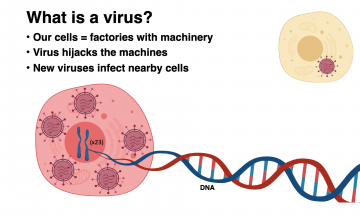
In Episode 1 of the English version of the series, Mahtab S. Gill explains what a virus is and how viruses “hijack” cells.
LC: First, we decide the main themes of each episode. We believe the order we picked is the most logical and helps introduce important concepts to build on as we go along. For each episode, we brainstorm a skeleton of the main points that we want to talk about, and in some cases how it relates to other episodes. Next, we research the main points, write up a script, and start making slides. It goes through several rounds of revisions, then we present the draft to each other and to our supervisor Hélène, critique what we like and don’t like, and make changes. Next, we present it at our lab meeting, where we gain more valuable input on how the information is conveyed. After that, we implement final changes and Mahtab makes the recording and posts it on YouTube. It’s the kind of thing that’s never perfect, where you could go back and edit it constantly. For instance, when we translate for the French videos, we inevitably find things we want to improve.
What do you like most about the process?
LC: The animations. They add so much to this type of presentation. Having what you envisioned take shape and seeing the finished product with the animations is very satisfying.
NG: What I like the most is that even though we are making this to teach younger people about these topics, I’m learning so much from it as well. Now I’m way more knowledgeable and able to speak to others about the topics in a way that I couldn’t before.
NY: I really enjoy when we have discussions about how to translate a complicated science concept into a relatable analogy for viewers. It’s fun and difficult to have to think about science creatively.
MG: Coming up with ideas and finding a way to convey them in lay language. It’s like a puzzle, you’re trying to find ways to say something really complicated in a more comprehensible way.
Why highlight SARS-CoV-2 and HIV in the same series?
MG: Since SARS-CoV-2 is a virus much like HIV, we thought it would be a great idea to relate what’s going on in the world right now and tie it back to our research in our lab, highlighting the similarities and differences between the two viruses.
LC: It also helps our series stand out from all the other information about SARS-CoV-2.
What are your tactics for making sure the information is accurate, but also understandable for those without expertise?
LC: We have to strike a balance between explaining exactly what’s going on and simplifying it for the audience and in the interest of time. I take myself back to when I was in high school and ask myself, “Would I have been able to understand this?” Student feedback has been very important as well. We’ve been getting a lot of positive feedback from students saying, “I can understand it now” and “I learned something new.” That kind of encouraging feedback confirms that we’ve been striking a good balance.
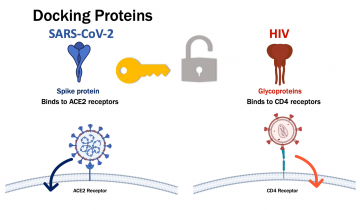
In Episode 2, Mahtab S. Gill explains the different docking proteins and mechanisms between HIV and SARS-CoV-2.
What has been the most difficult concept(s) to communicate through a YouTube video?
MG: Probably trying to explain the immune system in Episode 3. Condensing all the different players of the immune system into a 15-minute video, while also incorporating how both viruses affect the immune system, was a really big challenge. You’ll notice the other videos have a little more text, but with Episode 3 we really focused on the animations to get our ideas across.
NG: Another thing that is very difficult to explain concisely yet accurately is how different populations are affected differently by both viruses, with social determinants of health playing a big role. It’s a big and very important conversation to have. For these topics, we were limited by the format of our presentations, but we hope to spark deeper conversations on these issues.
What impact do you want this video series to make?
MG: If even just one student is left inspired by what we do as a research group, I think that’s the biggest impact you could have. I did a Q&A with a high school class and a lot of the questions were focused on how I got into research. It shows that some students are actually interested in getting into this field. Since I’m closer to their age, I think my experience feels more relevant to them.
LC: It’s important to me that people realize that science is all around them. We talk about topics such as what’s going on in your body, but we also touch on things that might seem far removed, like a cold artificial setting of a lab with enzymes and antibodies. We want to demonstrate that there’s so much crossover between science and society, for example in the healthcare field where many of the policies and how we live our lives are affected by research.
What advice would you give someone who also wants to share their scientific knowledge to diverse audiences?
LC: Don’t be afraid to put in your personal experience. If you have a certain way that makes sense to you, it’s likely that the same analogy or concept will make sense to others.
MG: Knowing your audience and how much they know is going to go really far to help find that correct balance of accuracy and simplicity. Also, a lot of hard work goes into preparing everything. Be prepared to spend the time doing the research, making a presentation or video, and then putting it all together.
Any last comments?
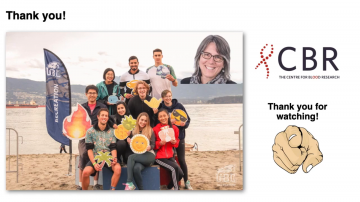
In the last episode of the Going Viral series, Mahtab S. Gill thanks the Côté Lab, the CBR and the viewers.
NY: I just want to say that I think it’s really remarkable how Mahtab has spearheaded this project. I think we can all attest that it’s not easy as an undergrad student to take the lead on a brand-new project in a well-established lab. It shows how impactful and wide-reaching a single summer project can be.
MG: This was a total team effort, I feel like this will sound cheesy, but we have built up this chemistry as a group, so it’s been very smooth. Even in our group chat, you can see that everyone is eager to help and share ideas, and we feed off that excitement.
LC: Having a similar vision for how the project would shape up in general has really helped us be on the same page, yet we all bring individual perspectives and different elements when putting it all together. A big thank you to everyone behind the scenes, the other members of the team, Hélène, and our lab members, as well as the CBR for their support and for providing this opportunity.
If you’ve made it this far, thank you! I appreciate your time and I hope you learned something new. Like, share, subscribe, etc. as we continue in the hopes of getting “Going Viral” to go, well, viral!
Going Viral video series:
- Watch the English version of the Going Viral videos here
- Watch the French version of the Going Viral videos here
- Read a recap about the CBR’s 2020 Research Day here
Marie-Soleil is a PhD Student in Dr. Hélène Côté’s lab at the UBC Hospital. When she’s not busy trying to identify the safest HIV antiretroviral for pregnant women, she likes to bake, do yoga, and work on 1000-piece puzzles.


